Management Practices Affect Soil Organic Carbon Stocks and Soil Fertility in Cactus Orchards
Abstract
:1. Introduction
2. Materials and Methods
2.1. Site Description and Establishment of the Experiment
2.2. Soil Sample Collection and Processing
2.3. Laboratory Analysis
2.4. Statistical Analysis
3. Results
3.1. Soil Chemical Characteristics
3.2. Soil C and N Contents and Stocks
4. Discussion
5. Conclusions
Author Contributions
Funding
Data Availability Statement
Acknowledgments
Conflicts of Interest
References
- IPCC—Intergovernmental Panel on Climate Change. AR6 Synthesis Report: Climate Change. 2023. Available online: https://www.ipcc.ch/report/ar6/syr/ (accessed on 15 July 2023).
- FAO—Food and agriculture Organization of the United Nations. FAO No Brasil. 2021. Available online: https://www.fao.org/brasil/noticias/detail-events/pt/c/1401429/ (accessed on 10 April 2023).
- Queiroz, M.G.; Silva, T.G.F.; Zolnier, S.; Jardim, A.M.R.F.; Souza, C.A.A.; Araújo Júnior, G.N.; Morais, J.E.F.; Souza, L.S.B. Spatial and temporal dynamics of soil moisture for surfaces with a change in land use in the semi-arid region of Brazil. Catena 2020, 188, 104457. [Google Scholar] [CrossRef]
- Salehi, E.; Emam-Djomeh, Z.; Askari, G.; Fathi, M. Opuntia ficus indica fruit gum: Extraction, characterization, antioxidant activity and functional properties. Carbohydr. Polym. 2019, 206, 565–572. [Google Scholar] [CrossRef] [PubMed]
- Krümpel, J.; George, T.; Gasston, B.; Francis, G.; Lemmer, A. Suitability of Opuntia ficus-indica (L) Mill. and Euphorbia tirucalli L. as energy crops for anaerobic digestion. J. Arid. Environ. 2020, 174, 104047. [Google Scholar] [CrossRef]
- Oliveira, J.P.F.; Ferreira, M.A.; Alves, A.M.S.V.; Melo, A.C.C.; Andrade, I.B.; Urbano, S.A.; Suassuna, J.M.A.; Barros, L.J.A.; Melo, T.T.B. Carcass characteristics of lambs fed spineless cactus as a replacement for sugarcane. Asian-Australas. J. Anim. Sci. 2018, 31, 529–536. [Google Scholar] [CrossRef] [PubMed]
- Santos, D.C.; Silva, M.C.; Alves, F.A.L.; Freitas, E.V. Botany and cultivars. In Forage Cactus from Planting to Harvesting; Donato, S.L.R., Rodrigues, M.G.V., Eds.; EPAMIG: Belo Horizonte, Brazil, 2020; pp. 21–41. [Google Scholar]
- Silva, E.T.S.; Melo, A.A.S.; Ferreira, M.A.; Oliveira, J.C.V.; Santos, D.C.; Silva, R.C.; Inácio, J.G. Acceptability by Girolando heifers and nutritional value of erect prickly pear stored for different periods. Pesq. Agropec. Bras. 2017, 52, 761–767. [Google Scholar] [CrossRef]
- Bezerra, J.D.C.; Andrade, A.P.; Rêgo, M.M.; Silva, D.S.; Nascimento Júnior, J.R.S.; Araújo, F.S.; Valença, R.L.; Rêgo, E.R.; Pessoa, A.M.S.; Bruno, R.L.A.; et al. Genetic diversity and relationships among Nopalea sp. and Opuntia spp. accessions revealed by RAPD, ISSR and ITS molecular markers. Mol. Biol. Rep. 2022, 49, 6207–6213. [Google Scholar] [CrossRef] [PubMed]
- Fonseca, V.A.; Santos, M.R.; Silva, J.A.; Donato, S.L.R.; Rodrigues, C.S.; Brito, C.F.B. Morpho-physiology, yield, and water-use efficiency of Opuntia ficus-indica irrigated with saline water. Acta Sci. Agron. 2019, 41, e42631. [Google Scholar] [CrossRef]
- Lima, L.R.; Silva, T.G.F.; Pereira, P.C.; Morais, J.E.F.; Assis, M.C.S. Productive-economic benefit of forage cactus-sorghum intercropping systems irrigated with saline water. Rev. Caatinga 2018, 31, 191–201. [Google Scholar] [CrossRef]
- Amorim, D.M.; Silva, T.G.F.; Pereira, P.C.; Souza, L.S.B.; Minuzzi, R.B. Phenophases and cutting time of forage cactus under irrigation and cropping systems. Pesq. Agropec. Trop. 2017, 47, 62–71. [Google Scholar] [CrossRef]
- Neto, J.D.; Matos, R.M.; Silva, P.F.; Lima, A.S.; Azevedo, C.A.V.; Saboya, L.M.F. Growth and yield of cactus pear under irrigation frequencies and nitrogen fertilization. R. Bras. Eng. Agríc. Ambient. 2020, 24, 664–671. [Google Scholar] [CrossRef]
- Padilha Junior, M.C.; Donato, S.L.R.; Donato, P.E.R.; Silva, J.A. Attributes of the soil with cactus pear under organic fertilization, different spacings and sampling times. Rev. Bras. Eng. Agríc. Ambient. 2020, 24, 444–450. [Google Scholar] [CrossRef]
- Miranda, K.R.; Dubeux Junior, J.C.B.; Mello, A.C.L.; Silva, M.C.; Santos, M.V.F.; Santos, D.C. Forage production and mineral composition of cactus intercropped with legumes and fertilized with different sources of manure. Cienc. Rural. 2019, 49, e20180324. [Google Scholar] [CrossRef]
- Coêlho, D.L.; Dubeux, J.C.B.; Santos, M.V.F.; Mello, A.C.L.; Cunha, M.V.; Almeida, B.G.; Santos, D.C.; Santos, E.R.S. Soil physical attributes and plant root mass in forage cactus production system. Acta Hortic. 2022, 1343, 39–46. [Google Scholar] [CrossRef]
- Dubeux Júnior, J.C.B.; Araújo Filho, J.T.; Santos, M.V.F.; Lira, M.A.; Santos, D.C.; Pessoa, R.A.S. Mineral fertilization effect on growth and chemical composition of cactus pear-clone IPA 20. Rev. Bras. Cienc. Agrar. 2010, 5, 129–135. [Google Scholar] [CrossRef]
- Rocha, R.S.; Voltolini, T.V.; Gava, C.A.T. Productive and structural characteristics of genotypes of irrigated spineless cactus in different cutting intervals. Arch. Zootec. 2017, 66, 363–371. [Google Scholar] [CrossRef]
- Santos, M.V.F.; Lira, M.A.; Dubeux, J.C.B., Jr.; Ferreira, M.A.; Cunha, M.V. Forage cactus. In Forage Plants; Fonseca, D.M., Martuscello, J.A., Eds.; UFV Publisher: Viçosa, Brazil, 2020; pp. 518–550. [Google Scholar]
- Soto, R.L.; Padilla, M.C.; Vente, J. Participatory selection of soil quality indicators for monitoring the impacts of regenerative agriculture on ecosystem services. Ecosyst. Serv. 2020, 45, 101157. [Google Scholar] [CrossRef]
- Coêlho, D.L. Soil and Root System Attributes in Different Forage Production Systems. Ph.D. Thesis, Federal Rural University of Pernambuco, Recife, Brazil, 2022. [Google Scholar]
- INMET—National Institute of Meteorology. Climatic Data from Arcoverde Station. 2017. Available online: https://www.inmet.gov.br/ (accessed on 5 August 2023).
- Santos, M.C. Semiarid Notebooks: Riches and Opportunities. Soils of the Semiarid Region of Brazil, 2nd ed.; EDUFRPE: Recife, Brazil, 2017. [Google Scholar]
- Mello, A.C.L.; Silva, R.M.; Souza, T.C.; Dubeux, J.C.B., Jr.; Lira, M.A.; Santos, M.V.F.; Coêlho, J.J.; Santos, D.C.; Cunha, M.V. Nutrient concentration in spineless cactus under different planting densities and harvesting management. Acta Hortic. 2019, 1247, 137–142. [Google Scholar] [CrossRef]
- Dubeux Junior, J.C.B.; Santos, M.V.F. Nutritional requirements of forage cactus. In Cactus in Northeast Brazil: Current Knowledge and New Perspectives of Use; Menezes, R.S.C., Simões, D.A., Sampaio, E.V.S.B., Eds.; University Press of UFPE: Recife, Brazil, 2005; pp. 105–128. [Google Scholar]
- EMBRAPA—Brazilian Agricultural Research Corporation. Manual of Soil Analysis Methods, 3rd ed.; Revised and Expanded; EMBRAPA: Brasília, Brazil, 2017. [Google Scholar]
- Bernoux, M.; Carvalho, M.C.S.; Volkoff, B.; Cerri, C.C. Brazil’s soil carbon stocks. Soil. Sci. Soc. Am. J. 2002, 66, 888–896. [Google Scholar] [CrossRef]
- Sisti, C.P.J.; Santos, H.P.; Kohhann, R.; Alves, B.J.R.; Urquiaga, S.; Boddey, R.M. Change in carbon and nitrogen stocks in soil under 13 years of conventional or zero tillage in southern Brazil. Soil. Tillage Res. 2004, 76, 39–58. [Google Scholar] [CrossRef]
- Malta, A.O.; Pereira, W.E.; Torres, M.N.N.; Malta, A.O.; Silva, E.S.; Silva, S.I.A. Physical and chemical attributes of soil cultivated with soursop, under organic and mineral fertilization. Revista PesquisAgro 2019, 2, 11–23. [Google Scholar] [CrossRef]
- Sobral, L.F.; Barreto, M.C.V.; Silva, A.J.; Anjos, J.L. Practical Guide to Interpreting Soil Test Results. 2015. Available online: https://www.bdpa.cnptia.embrapa.br (accessed on 12 March 2023).
- Wei, M.; Hu, G.; Wang, H.; Bai, E.; Lou, Y.; Zhang, A.; Zhuge, Y. 35 years of manure and chemical fertilizer application alters soil microbial community composition in a Fluvo-aquic soil in Northern China. Eur. J. Soil. Biol. 2017, 82, 27–34. [Google Scholar] [CrossRef]
- Zhang, X.; Xiang, D.Q.; Yang, C.; Wu, W.; Liu, H.B. The spatial variability of temporal changes in soil pH affected by topography and fertilization. Catena 2022, 218, 106586. [Google Scholar] [CrossRef]
- Andrade, F.V.; Mendonça, E.S.; Alvarez, V.H.; Novais, R.F. Addition of organic and humic acids to Latosols and phosphate adsorption effects. Rev. Bras. Cienc. Solo 2003, 27, 1003–1011. [Google Scholar] [CrossRef]
- Alves, R.N.; Farias, I.; Menezes, R.S.C.; Lira, M.A.; Santos, D.C. Prickly pear (Opuntia fícus indica) fodder production after 19 years of cultivation under different planting densities and harvest intensities. Rev. Caatinga 2007, 20, 38–44. [Google Scholar]
- Sanya, D.R.A.; Amadji, L.G. Application of cow manure and inorganic fertilizer in one season and carryover of effects in sesame on tropical ferruginous soils. Afr. J. Agric. Res. 2018, 13, 2207–2223. [Google Scholar] [CrossRef]
- Ramos, F.T.; Dores, E.F.G.C.; Weber, O.L.S.; Beber, D.C.; Campelo, J.H., Jr.; Maia, J.C.S. Soil organic matter doubles the cation exchange capacity of tropical soil under no-till farming in Brazil. J. Sci. Food Agric. 2018, 98, 3595–3602. [Google Scholar] [CrossRef] [PubMed]
- Donato, P.E.R.; Donato, S.L.R.; Silva, J.A.; Pires, A.J.V.; Silva Junior, A.A. Extraction/exportation of macronutrients by cladodes of ‘Gigante’ cactus pear under different spacings and organic fertilization. Rev. Bras. Eng. Agric. Ambient. 2017, 21, 238–243. [Google Scholar] [CrossRef]
- Jardim, A.M.R.F.; Araújo Júnior, G.N.; Silva, M.J.; Morais, J.E.F.; Silva, T.G.F. Estimates of loss of soil by water erosion to the municipality of Serra Talhada, PE. J. Environ. Anal. Prog. 2017, 2, 186–193. [Google Scholar] [CrossRef]
- Alves, H.K.M.N.; Jardim, A.M.R.F.; Souza, L.S.B.; Silva, T.G.F. The application of agrometeorological techniques contributes to the agricultural resilience of forage cactus: A review. Amazon. J. Plant Res. 2018, 2, 207–220. [Google Scholar] [CrossRef]
- Shah, M.N.; Wright, D.L.; Hussain, S.; Koutroubas, S.D.; Seepaul, R.; George, S.; Ali, S.; Naveed, M.; Khan, M.; Altaf, M.T.; et al. Organic fertilizer sources improve the yield and quality attributes of maize (Zea mays L.) hybrids by improving soil properties and nutrient uptake under drought stress. J. King Saud. Univ. Sci. 2023, 35, 102570. [Google Scholar] [CrossRef]
- Donato, P.E.R.; Pires, A.J.V.; Donato, S.L.R.; Bonomo, P.; Silva, J.A.; Aquino, A.A. Morphometry and yield of cactus pear ‘Gigante’ grown under different spacing and doses of organic fertilization. Rev. Bras. Cienc. Agrar. 2014, 9, 151–158. [Google Scholar] [CrossRef]
- Hao, T.; Zhu, Q.; Zeng, M.; Shen, J.; Shi, X.; Liu, X.; Zhang, F.; Vries, W. Impacts of nitrogen fertilizer type and application rate on soil acidification rate under a wheat-maize double cropping system. J. Environ. Manag. 2020, 270, 110888. [Google Scholar] [CrossRef]
- Behera, S.K.; Shukla, A.K. Spatial distribution of surface soil acidity, electrical conductivity, soil organic carbon content and exchangeable potassium, calcium and magnesium in some cropped acid soils of India. Land. Degrad. Dev. 2015, 26, 71–79. [Google Scholar] [CrossRef]
- Molokobate, M.S.; Haynes, R.J. A glasshouse evaluation of the comparative effects of organic amendments, lime and phosphate on alleviation of Al toxicity and P deficiency in an Oxisol. J. Agric. Sci. 2003, 140, 409–417. [Google Scholar] [CrossRef]
- Dai, P.; Cong, P.; Wang, P.; Dong, J.; Dong, Z.; Song, W. Alleviating soil acidification and increasing the organic carbon pool by long-term organic fertilizer on tobacco planting soil. Agronomy 2021, 11, 2135. [Google Scholar] [CrossRef]
- Ahmed, W.; Jing, H.; Kaillou, L.; Qaswar, M.; Khan, M.N.; Jin, C.; Geng, S.; Qinghai, H.; Yiren, L.; Guangrong, L.; et al. Changes in phosphorus fractions associated with soil chemical properties under long-term organic and inorganic fertilization in paddy soils of southern China. PLoS ONE 2019, 14, e0216881. [Google Scholar] [CrossRef]
- Gomes, G.M.F.; Cândido, M.J.D.; Lopes, M.N.; Maranhão, T.D.; Andrade, D.R.; Costa, J.F.M.; Silveira, W.M.; Neiva, J.N.M. Chemical composition of cactus pear cladodes under different fertilization and harvesting managements. Pesq. Agropec. Bras. 2018, 53, 221–228. [Google Scholar] [CrossRef]
- Dubeux Júnior, J.C.B.; Ben Salem, H.; Nefzaoui, A. Producción y utilización de nopal forrajero en la nutrición animal. In Ecologia del Cultivo, Manejo y Usos del Nopal; Inglese, P., Jacobo, C.M., Nefzaoui, A., Sáenz, C., Eds.; FAO: Rome, Italy, 2018; pp. 77–96. [Google Scholar]
- Han, J.; Dong, Y.; Zhang, M. Chemical fertilizer reduction with organic fertilizer effectively improve soil fertility and microbial community from newly cultivated land in the Loess Plateau of China. Appl. Soil. Ecol. 2021, 165, 103966. [Google Scholar] [CrossRef]
- Saraiva, F.M.; Dubeux, J.C.B., Jr.; Cunha, M.V.; Menezes, R.S.C.; Santos, M.V.F.; Camelo, D.; Ferraz, I. Manure source and cropping system affect nutrient uptake by cactus (Nopalea cochenillifera Salm Dyck). Agronomy 2021, 11, 1512. [Google Scholar] [CrossRef]
- Lima, G.F.C.; Rêgo, M.M.T.; Aguiar, E.M.; Silva, J.G.M.; Dantas, F.D.G.; Guedes, F.X.; Lobo, R.N.B. Effect of defferent cutting intensities on morphological characteristics and productivity of irrigated Nopalea forage cactus. Acta Hortic. 2015, 1067, 253–258. [Google Scholar] [CrossRef]
- Donato, P.E.R.; Pires, A.J.V.; Donato, S.L.R.; Silva, J.A.; Aquino, A.A. Nutritional value of cactus pear ‘Gigante’ cultivated under different spacing and cattle manure. Rev. Caatinga 2014, 27, 163–172. [Google Scholar]
- Souto Filho, L.T. Morphology, Productivity and Chemical Composition of the Cactus Pear Orelha de Elefante Mexicana under Fertilization and Harvest Frequency. Ph.D. Thesis, Federal Rural University of Pernambuco, Recife, Brazil, 2020. [Google Scholar]
- Rodrigues, J.O.; Partelli, F.L.; Pires, F.R.; Oliosi, G.; Espindula, M.C.; Monte, J.A. Ammonia volatilisation from coated urea in conilon coffee crop. Coffee Sci. 2016, 11, 530–537. [Google Scholar]
- Paolini, V.; Petracchini, F.; Segreto, M.; Tomassetti, L.; Naja, N.; Cecinato, A. Environmental impact of biogas: A short review of current knowledge. J. Environ. Sci. Health 2018, 53, 899–906. [Google Scholar] [CrossRef]
- Jardim, A.M.R.F.; Silva, J.R.I.; Leite, M.L.M.V.; Teixeira, V.I.; Morato, R.P.; Júnior, G.N.A.; Silva, T.G.F. Symbiotic interaction in forage crop cultivations: A review. Amazon. J. Plant Res. 2018, 2, 149–160. [Google Scholar] [CrossRef]
- Li, T.; Zhang, Y.; Bei, S.; Li, X.; Reinsch, S.; Zhang, H.; Zhang, J. Contrasting impacts of manure and inorganic fertilizer applications for nine years on soil organic carbon and its labile fractions in bulk soil and soil aggregates. Catena 2020, 194, 104739. [Google Scholar] [CrossRef]
- Tu, C.; He, T.; Lu, X.; Luo, Y.; Smith, P. Extent to which pH and topographic factors control soil organic carbon level in dry farming cropland soils of the mountainous region of Southwest China. Catena 2018, 163, 204–209. [Google Scholar] [CrossRef]
- Heyn, N.; Joergensen, R.G.; Wachendorf, C. Soil organic C and N stocks in the first rotation or poplar plantations in Germany. Geoderma Reg. 2019, 16, e00211. [Google Scholar] [CrossRef]
- Gross, A.; Glaser, B. Meta-analysis on how manure application changes soil organic carbon storage. Sci. Rep. 2021, 11, 5516. [Google Scholar] [CrossRef] [PubMed]
- Steffen, W.; Richardson, K.; Rockström, J.; Cornell, S.E.; Fetzer, I.; Bennett, E.M.; Biggs, R.; Carpenter, S.R.; Vries, W.; Wit, C.A.; et al. Planetary boundaries: Guiding human development on a changing planet. Science 2015, 347, 1259855. [Google Scholar] [CrossRef]
- Tian, H.; Xu, R.; Canadell, J.G.; Thompson, R.L.; Winiwarter, W.; Suntharalingam, P.; Davidson, E.A.; Ciais, P.; Jackson, R.B.; Janssens-Maenhout, G.; et al. A comprehensive quantification of global nitrous oxide sources and sinks. Nature 2020, 586, 248–256. [Google Scholar] [CrossRef]
- Gu, B.; Zhang, L.; Dingenen, R.V.; Vieno, M.; Grinsven, H.J.V.; Zhang, X.; Zhang, S.; Chen, Y.; Wang, S.; Ren, C.; et al. Abating ammonia is more cost-effective than nitrogen oxides for mitigating PM2.5 air pollution. Science 2021, 374, 758–762. [Google Scholar] [CrossRef]
- Schulte-Uebbing, L.F.; Beusen, A.H.W.; Bouwman, A.F.; Vries, W. From planetary to regional boundaries for agricultural nitrogen pollution. Nature 2022, 610, 507–512. [Google Scholar] [CrossRef] [PubMed]
- Gao, L.; Becker, E.; Liang, G.; Houssou, A.A.; Wu, H.; Wu, X.; Cai, D.; Degré, A. Effect of different tillage systems on aggregate structure and inner distribution of organic carbon. Geoderma 2017, 288, 97–104. [Google Scholar] [CrossRef]
- Paustian, K.; Lehmann, J.; Ogle, S.; Reay, D.; Robertson, G.P.; Smith, P. Climate-smart soils. Nature 2016, 532, 49–57. [Google Scholar] [CrossRef] [PubMed]
- Chabbi, A.; Lehmann, J.; Ciais, P.; Loescher, H.W.; Cotrufo, M.F.; Don, A.; SanClements, M.; Schipper, L.; Six, J.; Smith, P.; et al. Aligning agriculture and climate policy. Nat. Clim. Change 2017, 7, 307–309. [Google Scholar] [CrossRef]
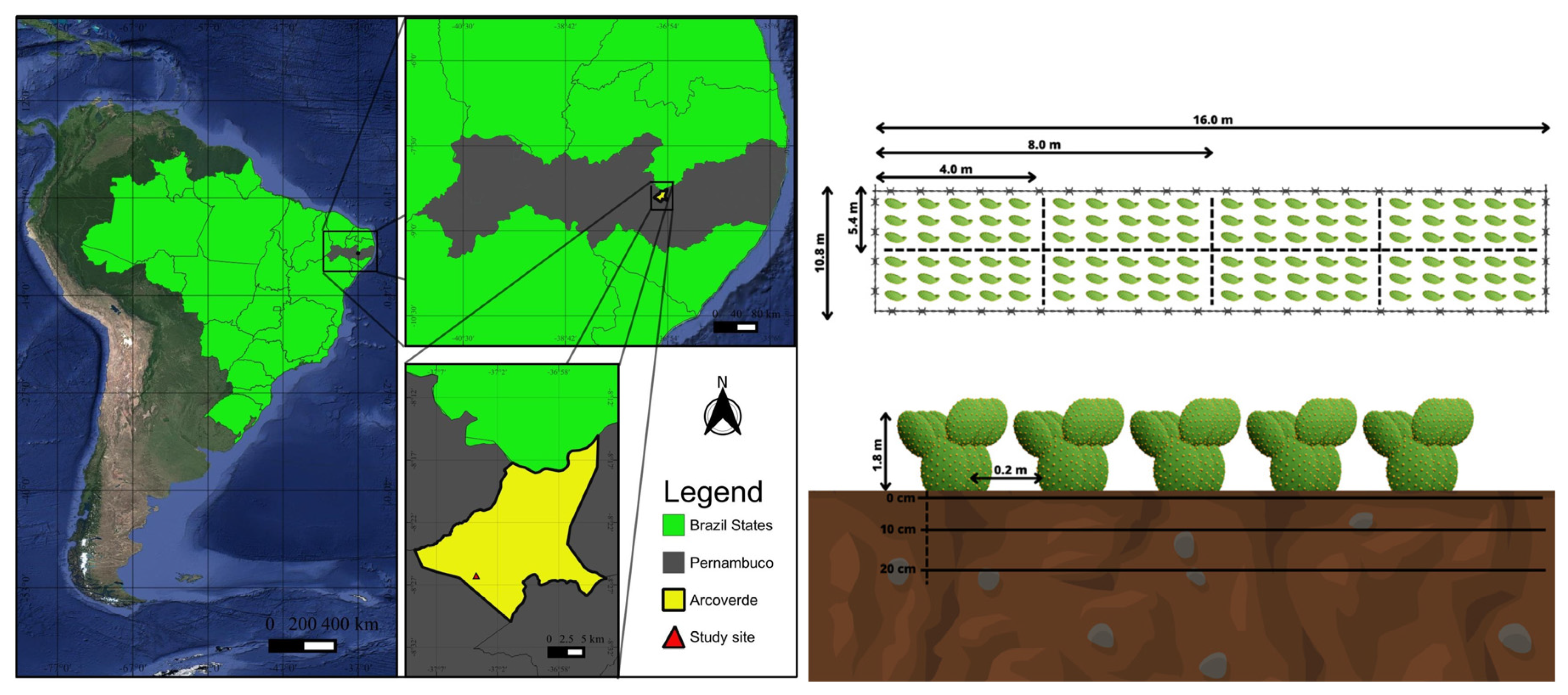

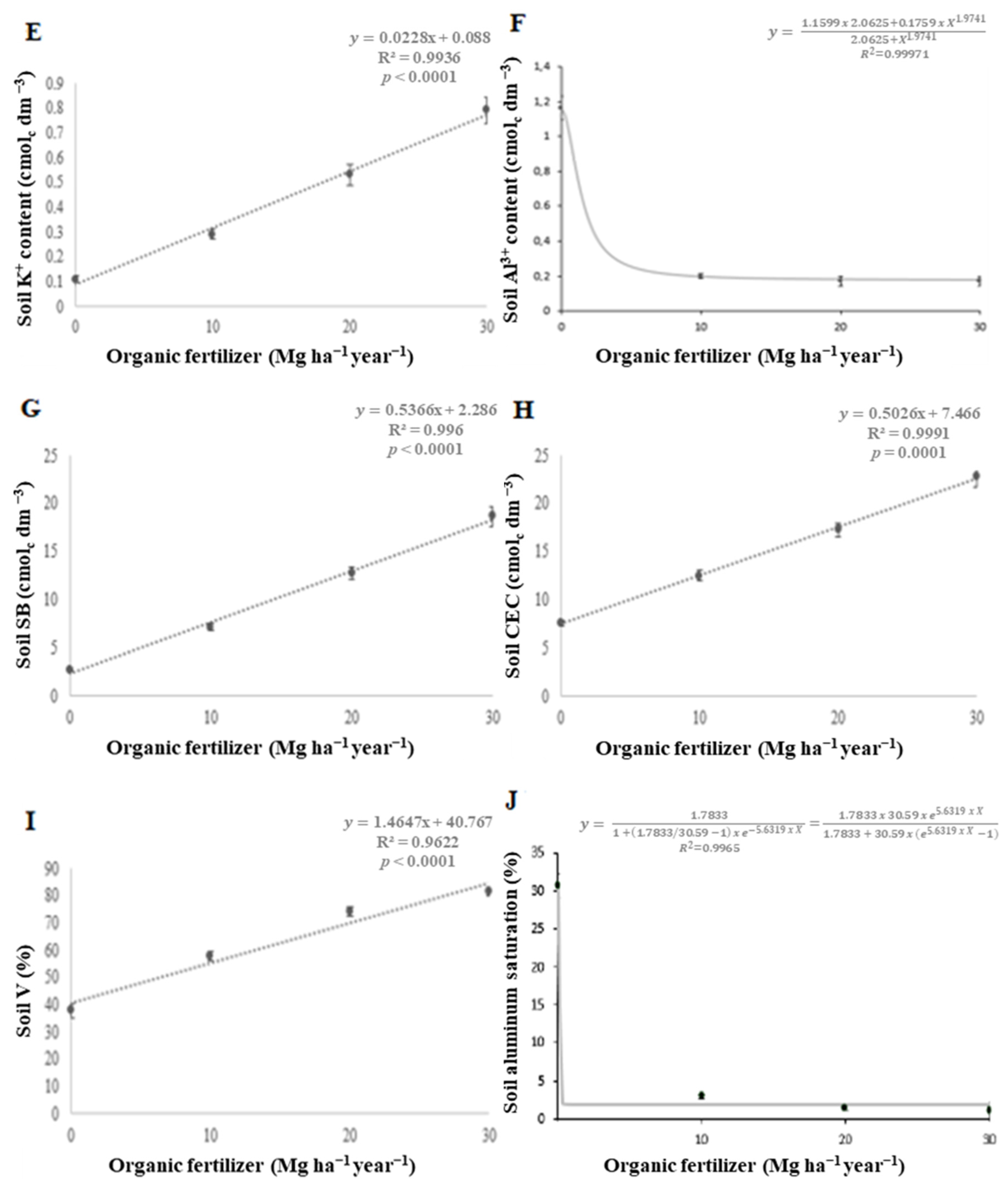
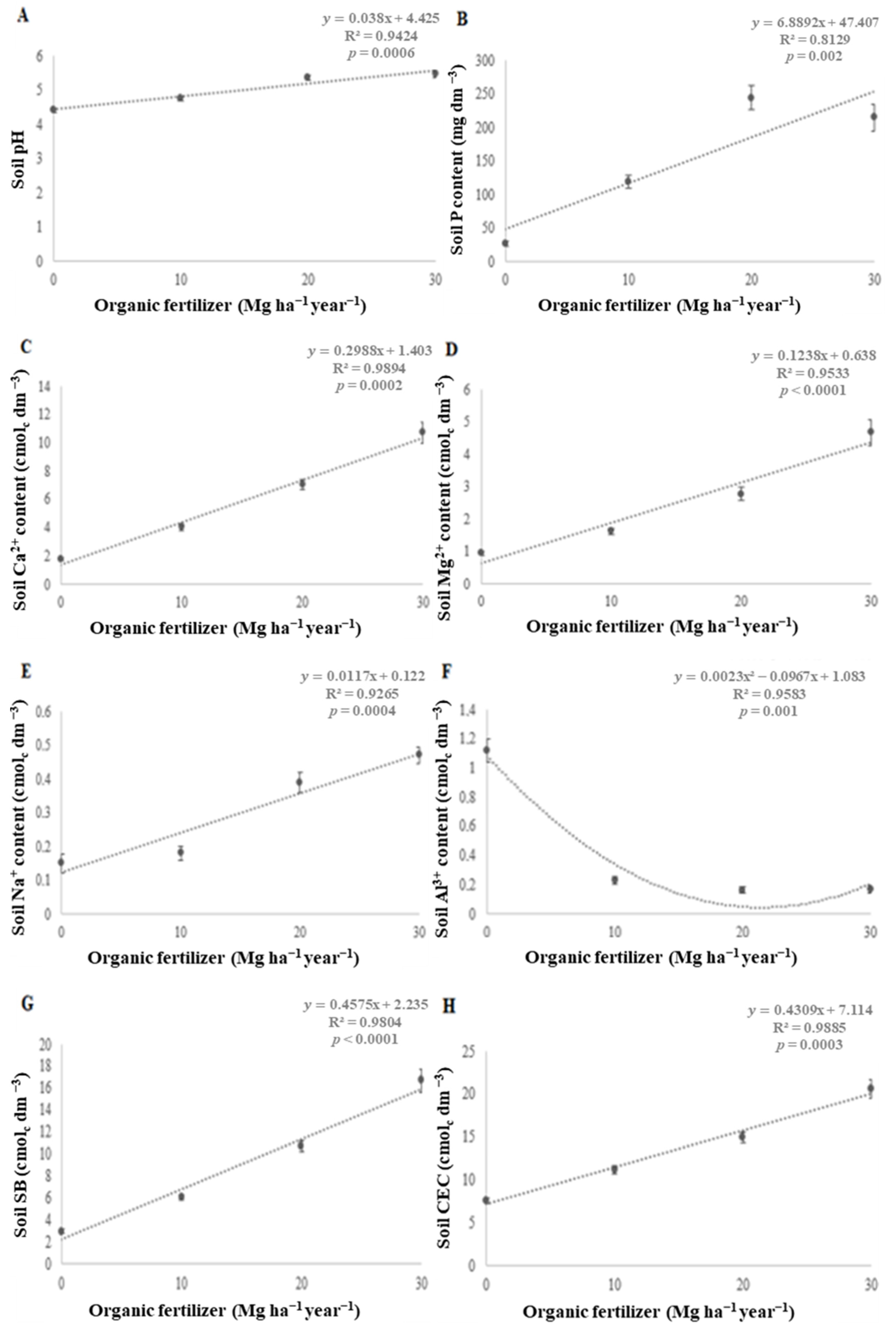
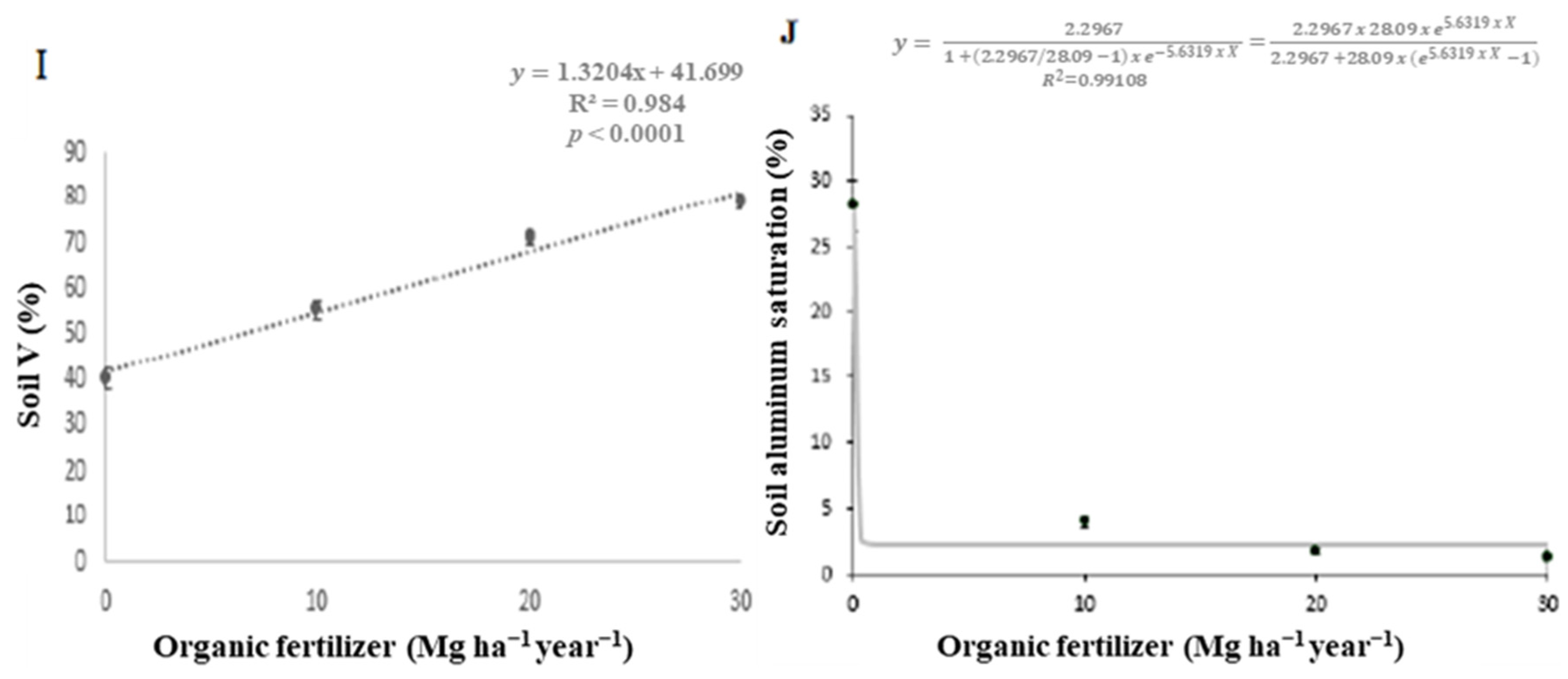
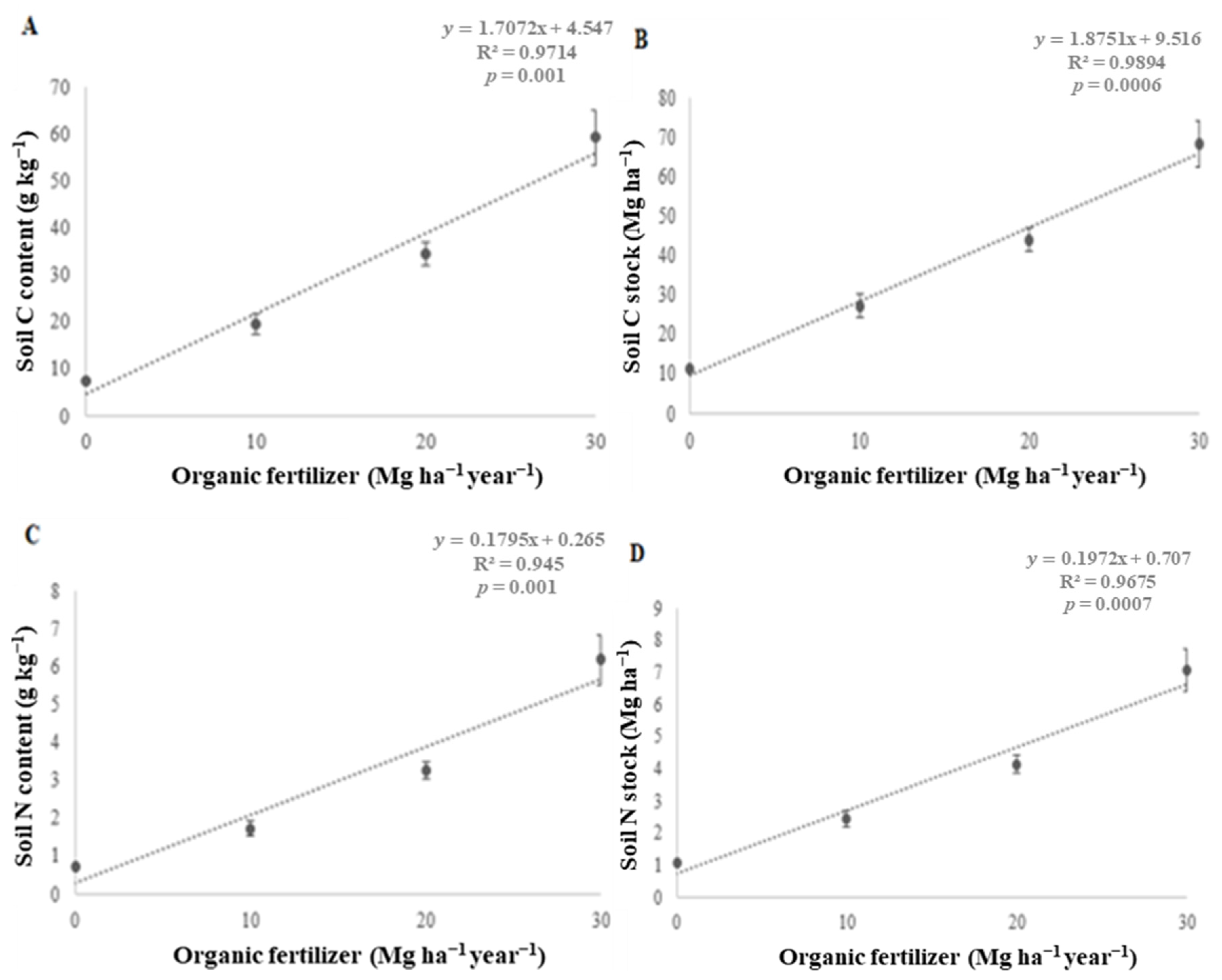
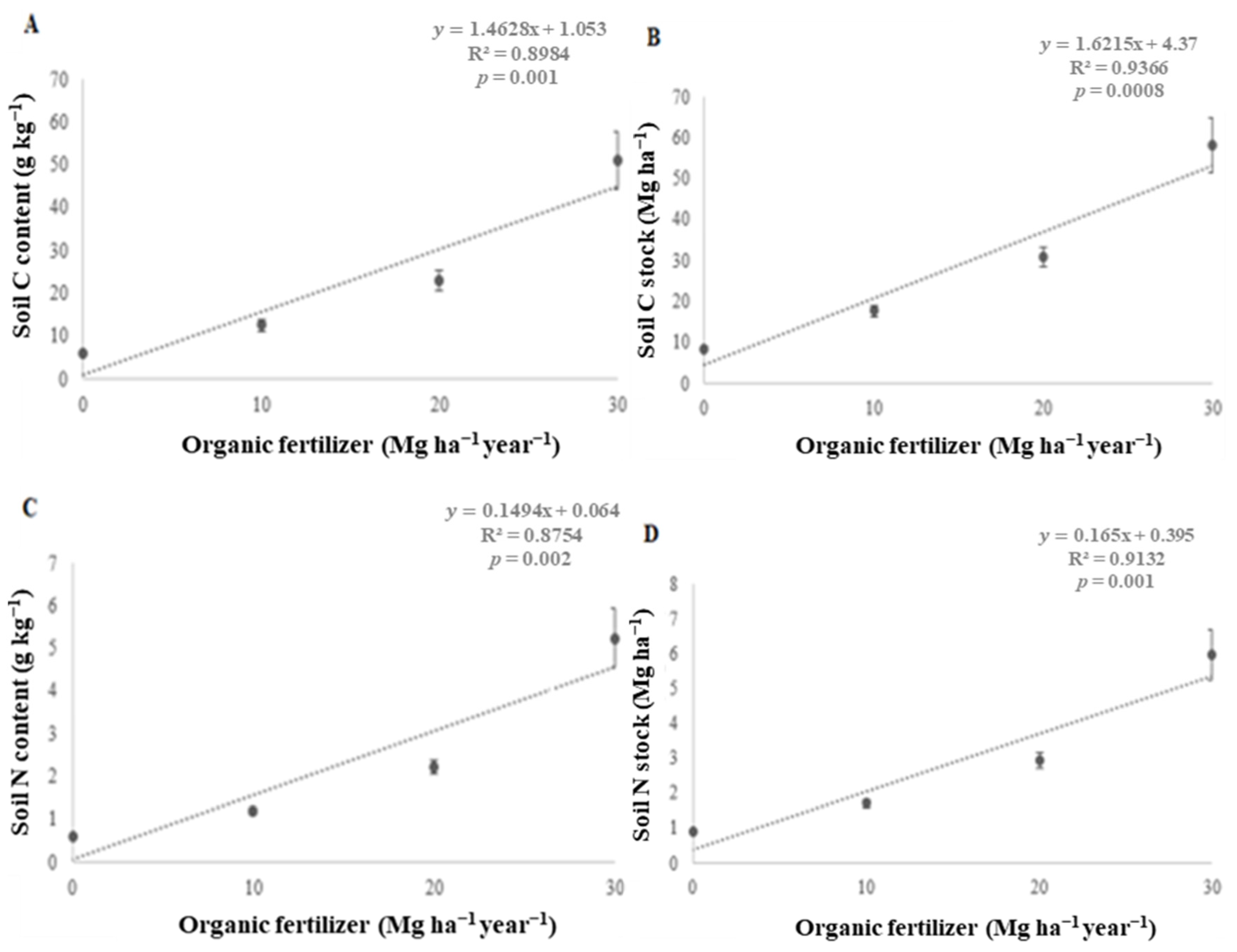
| P | pH | Ca2+ | Mg2+ | Na+ | K+ | Al3+ | SB | CEC | V | OM |
| mg dm−3 | cmolc dm−3 | g kg−1 | ||||||||
| 24.14 | 5.62 | 3.73 | 0.86 | 0.13 | 0.22 | 0.05 | 4.90 | 7.10 | 690.00 | 19.00 |
| Factor | Soil Mg2+ Content | |||
|---|---|---|---|---|
| cmolc dm−3 | ||||
| Inorganic nitrogen fertilizer | ||||
| Organic fertilizer | 0 kg N ha−1 year−1 | 120 kg N ha−1 year−1 | 240 kg N ha−1 year−1 | 360 kg N ha−1 year−1 |
| 0 Mg ha−1 year−1 | 1.00 Ba | 0.99 Aa | 0.71 Aa | 0.73 Ba |
| 10 Mg ha−1 year−1 | 2.08 Ba | 1.71 Aa | 1.53 Aa | 1.71 Ba |
| 20 Mg ha−1 year−1 | 2.04 Ba | 3.63 Aa | 3.19 Aa | 2.78 ABa |
| 30 Mg ha−1 year−1 | 6.78 Aa | 3.94 Aa | 3.94 Aa | 5.78 Aa |
| p-value | 0.02 | |||
| Standard error | 0.70 | |||
| Factor | Soil K+ Content | |
|---|---|---|
| cmolc dm−3 | ||
| Harvesting frequency | ||
| Organic fertilizer | Annual | Biennial |
| 0 Mg ha−1 year−1 | 0.10 Ca | 0.11 Ba |
| 10 Mg ha−1 year−1 | 0.25 BCa | 0.22 Ba |
| 20 Mg ha−1 year−1 | 0.52 Ba | 0.39 ABa |
| 30 Mg ha−1 year−1 | 0.99 Aa | 0.66 Ab |
| p-value | 0.01 | |
| Standard error | 0.08 | |
| Factor | Soil Al3+ Content | |
|---|---|---|
| cmolc dm−3 | ||
| Harvesting frequency | ||
| Inorganic nitrogen fertilizer | Annual | Biennial |
| 0 kg N ha−1 year−1 | 0.33 Ba | 0.34 Aa |
| 120 kg N ha−1 year−1 | 0.36 ABa | 0.45 Aa |
| 240 kg N ha−1 year−1 | 0.44 ABa | 0.50 Aa |
| 360 kg N ha−1 year−1 | 0.55 Aa | 0.39 Aa |
| p-value | 0.03 | |
| Standard error | 0.06 | |
Disclaimer/Publisher’s Note: The statements, opinions and data contained in all publications are solely those of the individual author(s) and contributor(s) and not of MDPI and/or the editor(s). MDPI and/or the editor(s) disclaim responsibility for any injury to people or property resulting from any ideas, methods, instructions or products referred to in the content. |
© 2023 by the authors. Licensee MDPI, Basel, Switzerland. This article is an open access article distributed under the terms and conditions of the Creative Commons Attribution (CC BY) license (https://creativecommons.org/licenses/by/4.0/).
Share and Cite
Coêlho, D.d.L.; Dubeux, J.C.B., Jr.; Santos, M.V.F.d.; Mello, A.C.L.d.; Cunha, M.V.d.; Santos, D.C.d.; Freitas, E.V.d.; Santos, E.R.d.S.; Silva, N.V.d. Management Practices Affect Soil Organic Carbon Stocks and Soil Fertility in Cactus Orchards. Agronomy 2023, 13, 2986. https://doi.org/10.3390/agronomy13122986
Coêlho DdL, Dubeux JCB Jr., Santos MVFd, Mello ACLd, Cunha MVd, Santos DCd, Freitas EVd, Santos ERdS, Silva NVd. Management Practices Affect Soil Organic Carbon Stocks and Soil Fertility in Cactus Orchards. Agronomy. 2023; 13(12):2986. https://doi.org/10.3390/agronomy13122986
Chicago/Turabian StyleCoêlho, Diego de Lima, José Carlos Batista Dubeux, Jr., Mércia Virginia Ferreira dos Santos, Alexandre Carneiro Leão de Mello, Márcio Vieira da Cunha, Djalma Cordeiro dos Santos, Erinaldo Viana de Freitas, Erick Rodrigo da Silva Santos, and Natália Viana da Silva. 2023. "Management Practices Affect Soil Organic Carbon Stocks and Soil Fertility in Cactus Orchards" Agronomy 13, no. 12: 2986. https://doi.org/10.3390/agronomy13122986





